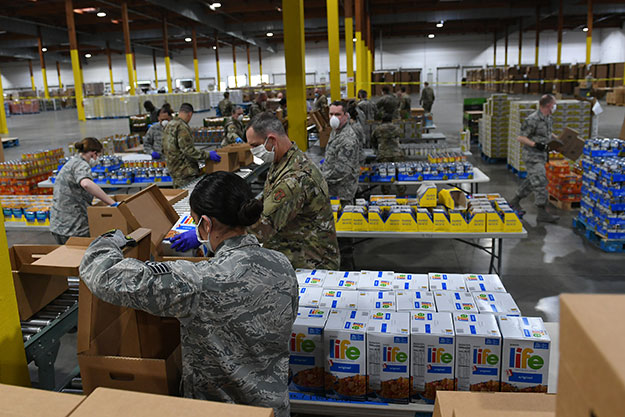(Photo: Washington Air National Guardsmen prepare food boxes at the Food Lifeline Covid Response warehouse April 23 in Seattle. More than 250 Air and Army National Guardsmen are assigned to the warehouse where they are able to prepare, on average, 268 boxes an hour per line.)
As one Washington Air National Guardsman finishes building a cardboard box, an assembly line of other airmen fill it with non-perishable food at the Food Lifeline Covid Response Center warehouse in Seattle. The work is straightforward but the mission is essential to the COVID-19 statewide emergency food response.
Nearly 50 airmen from the Headquarters Washington Air National Guard, 141st Air Refueling Wing, 194th Wing and Western Air Defense Sector started the mission April 20 and are part of a larger group of more than 250 Washington National Guardsmen working at the Food Lifeline warehouse.
 Amythst Shipman, Food Lifeline Director of Operations Strategy, had never worked with the National Guard and didn't know what to expect, but her organization needed help due to the loss of volunteer labor.
Amythst Shipman, Food Lifeline Director of Operations Strategy, had never worked with the National Guard and didn't know what to expect, but her organization needed help due to the loss of volunteer labor.
"Before our National Guard partnership started on (April 20), we had to make the really hard decision to shut down our volunteer program due to social distancing requirements, concerns volunteers were having about their own personal safety and health," she said. "Our volunteer numbers dropped to nearly nothing as a result of COVID."
Donations also sharply dropped while the need doubled from 800,000 people to 1.6 million people in the 17 counties in western Washington that Food Lifeline serves, Shipman said.
"Being able to call the National Guard has completely opened that food stream back up ... to meet the need in western Washington."
Staff Sgt. Matthew Bradley, a Western Air Defense Sector airman training to become a surveillance technician, said that the group's military training contributed to them packing more than 200,000 pounds of food their first full day of work.
"They actually tell us to slow down because we're moving so fast. That's just part of our work ethic," Bradley said.
According to Shipman, her staff and volunteers produced 70 boxes per hour per line during initial trials. National Guardsmen are producing on average 268 boxes per line per hour.
"They are blowing all of my metrics out of the water," she said.
In the first four days of work here, Guardsmen packed 556,480 pounds of food, according to Maj. Kenneth Reiley, the officer in charge at the site and S1 for the Washington Army National Guard's 205th Regional Training Institute Headquarters.
"We have consistently been able to overcome backlogs and complete tasks, delivering additional food to those in need," Reiley said. "I am thrilled to have the opportunity to serve our community and make a difference to those in need."
Working as a team to impact a bigger mission, one of the senior enlisted members at the site compared the experience to a past deployment.
"You look at any mission, there are so many enablers," said Senior Master Sgt. Mark Conrad, a Regional Force Support Liaison Team for FEMA Region 10 at the Headquarters Washington Air National Guard.
"There are a few actual warfighters and everything else is a support or logistics piece of enabling that mission," he said. "This is a huge enabling mission here to go out and deliver supplies to other food banks and those in need ... and we're fighting an enemy, COVID."
While being proud to serve his country by helping the statewide emergency food response, Senior Master Sgt. Bruce Perkins, the 194th Wing's Safety Superintendent, said he was also impressed by the team camaraderie and adherence to safety.
"People are taking safety to heart. We have three production lines ... some people are working on the left side, and then they swap to the right side because they don't want their left side to hurt," Perkins said. "That's taking safety to the next level."
With the operation running smoothly and more western Washington families being fed, Shipman reflected on her experience so far with the Washington National Guard.
"I have been just completely blown away by the high-level productivity, the really clear communication, the way that your leadership operates ... and then down to everybody who's on site has just been incredible to work with," Shipman said.
Statewide, nearly 500 Guardsmen are supporting more than 40 food banks and distribution centers for the COVID-19 statewide emergency food response.





Read Comments